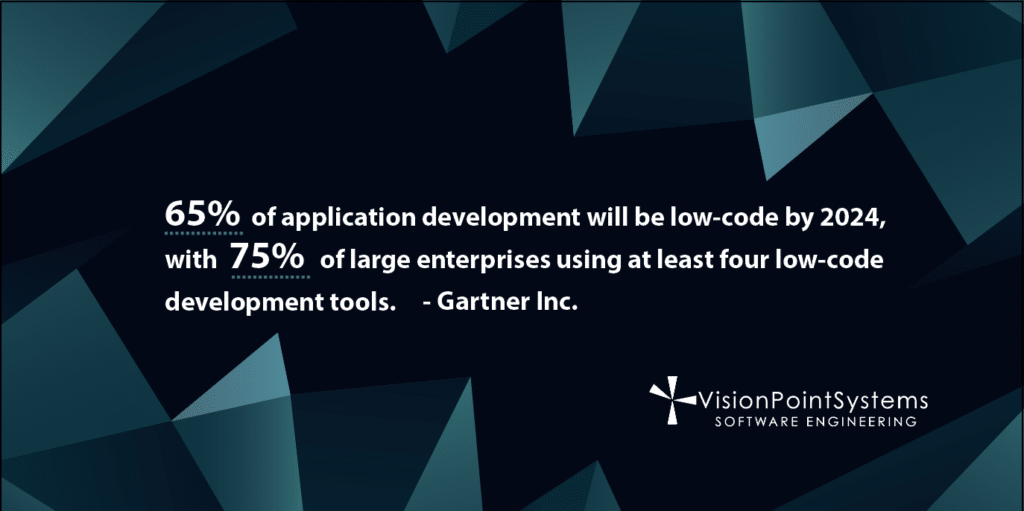Leveraging Low-Code to Modernize Your Contact Center
Low-Code and No-Code Platforms: Expediting Digital Transformation
Low-code and no-code platforms are software solutions that can drastically simplify key processes for businesses. Many software solutions are overcomplicated, difficult to develop, and hard to grasp for average business users. Low-code and no-code platforms accelerate the enterprise application development process, and allow developers and non-developers to collaborate on bringing production-ready systems into reality. No-code and low-code solutions are rapidly gaining popularity for enterprises around the world. According to Forbes, Gartner Inc. predicts that 65% of application development will be low-code by 2024, with 75% of large enterprises using at least four low-code development tools.

No-code and low-code solutions are expediting digital transformations across several key sectors. From finance to sales, low-code development increases business agility and allows businesses to more easily create custom applications. With the advent of Programmable Contact Centers, like Twilio Flex, low-code tools provide an opportunity to create a dynamic customer experience that has the agility to change and adapt to your business.
Contact centers are integral to achieving business goals, as they define customer experiences. As the most common point of interaction for customers, they are essential components of successful delivery over any business’s products or services. Low-code solutions can go a long way towards helping businesses improve the performance and impact of contact centers and contact center employees.
Contact center low-code solutions can be built from scratch or optimized by experts like Vision Point Systems to maximize immediate effectiveness and long-term results. Let’s look at some of the benefits of leveraging low-code for contact centers.
Low-Code Contact Centers and Customer Satisfaction
The modern contact center has a more difficult road to customer satisfaction than ever before. Customers today expect to be able to communicate across multiple channels – from chatbots and virtual assistants to live conversations with customer service representatives over voice, text or in-app. Today’s contact center customer journey is complicated and non-linear, and businesses have to make that experience seamless while providing exceptional customer experiences throughout.
Managing the conflicting needs and desires of customers is no easy task. According to HubSpot, 48% of customers prefer to speak to agents over the phone, 42% prefer live chat, and matching the varying demands of a diverse set of customers takes a flexible platform customized to your business’s specific needs. This is where low-code applications can help to improve customer satisfaction with contact centers.
Customized low-code platforms can improve the speed and simplicity of the customer journey and give businesses easy-to-use and customized tools that can help them create high-quality digital interactions. Modern, dynamic, and intelligent interactions rely on having access to customer and product data in real time. Low-Code platforms excel at unifying these data sets and providing easy-to-configure API integrations to access information such as customer demographics, order history, and product information that can be referenced in self-service or agent-assisted support interactions.
According to DevOps Digest, 84% of enterprises have turned toward low-code platforms for their ability to reduce strain on IT resources, increase speed to market, and create new offerings. These features will go a long way towards creating a contact center that meets the highest customer expectations.
Complete Automation Capabilities for Enterprise Workflows
Automation is becoming a must for businesses in the Communication Platform as a Service, or CPaaS, industry. Automation and Artificial Intelligence allow businesses to increase the capacity of customers they can handle, simplify workflows for their employees, and provide a more seamless customer journey. Low-code platforms allow for implementing AI and automation systems that can drastically improve call center performances.
Automation is a contact center solution businesses are already prioritizing in large numbers. According to No Jitter, 42.3% of businesses use at least one AI-enabled application right now, with another 21.9% planning to add it on by the end of the year.
AI automation on a low-code platform can do several things for contact centers that improve the customer service experience. AI Chat Bots can answer customer questions and create an initial screening phase for business, while automatic call distribution can connect the right employees to customer queries. For agents, workflows are optimized even after the call is answered. Call routing strategies and process automation help contact centers keep a unified, standardized system that is better organized for agents and customers.
Intelligent automation can lead to a more structured workflow for employees and a better experience for customers. Customer service automation in the form of a virtual assistant can make for the easy gathering of information like the reason for the call, call history, and so on, as well as a variety of other practical purposes. These low-code tools can be implemented on a customizable platform that allows for complete automation capabilities of your contact center’s workflows.
Enabling Integration of Contact Center Processes
We’ve discussed how important the non-linear, multi-channel experience is to customer engagement with contact centers, but integrating these tools seamlessly can be a hassle without the right tools. An Artificial Intelligence-driven, fully-customized low-code contact center platform can integrate all the various systems and solutions you are using or looking to use in your contact center.
Contact centers have many moving parts, with conflicting customer demands and differing customer preferences for communication methods. Low-code platforms are a way to seamlessly connect all the dots by blending the various tools, ranging from virtual assistants, chatbots, and live chat with your contact center experts’ phone services.
An example of this integration in action is Aviva, a multinational insurance company. Aviva’s contact center agents were struggling due to the company’s growth. Aviva had acquired over 150 different insurance companies, and call center agents had to sort through massive amounts of data to take the right actions. With the help of Appian’s low-code platform, they were able to consolidate 22 separate agent windows to one, creating a single unified platform that made agents’ jobs far easier. An important component of this integration is low-code platforms’ ability to collect data.
Data on the performance of various call center components will help businesses learn which aspects are working and which aren’t. Because low-code platforms are customizable, the work doesn’t stop when they’ve been deployed. They can be continuously optimized to yield better results over a longer period. You can also use them to integrate new processes as your business grows and your contact center offerings change.
Conclusion
The customer experience is one of the core things inspiring businesses to push for digital transformation. According to Futurum, 68% of decision-makers believe that improving customer experience is the primary thing driving digital transformation. Contact centers are one of the core aspects of the customer experience, and while many businesses have long-established practices, contact centers can be improved and optimized with the help of low-code platforms.
Low-code platforms allow for extensive contact center customization, with the integration of different processes and the automation of key areas. Businesses can create more compelling customer journeys and respond more quickly to complaints. Adapting to your customers’ needs is how businesses can drive growth in a digital age where customers expect personalized experiences tailored to their preferences.
Low-code platforms can help lead to a contact center that achieves more consistent customer success. They are easy to use, entirely customizable, and can be changed according to shifting business needs or easily integrated with new technology. If you are searching for a way to modernize your contact center, low-code platforms are a logical path forward.
Low-code development is an ever-evolving journey, and if you are seeking the best possible way to start this journey, Vision Point Systems may be for you. VPS is a team of experts who can help businesses optimize or develop their own fully-customized low-code solutions. VPS takes a consultative approach to the development, working side-by-side with businesses to create solutions that integrate your tech stack and scale alongside your business. Contact Us Today to discover how we can help transform your call center process and improve the customer experience.

